The new image of Chinese women over 30 has broken people’s previous conceptions about this dynamic consumer group. Chinese women bear a heavy load of social pressures: if women were not married or have not had children at the age of thirty, they were shunned with the phrase ‘leftover women’. However, Chinese women have stood up to change this stereotype, and one by-product is new TV shows showing the empowerment and capability of women over 30. This mighty consumer base includes independent working women who can afford their own luxuries, adventurous singles who live for the experience and matriarchs who make purchasing decisions for the three to four generations.
The demographics of Chinese women over 30 is shifting
Though born during the one-child-policy, the population size of Chinese women aged 30-34 has also maintained an upward trend since 2015.
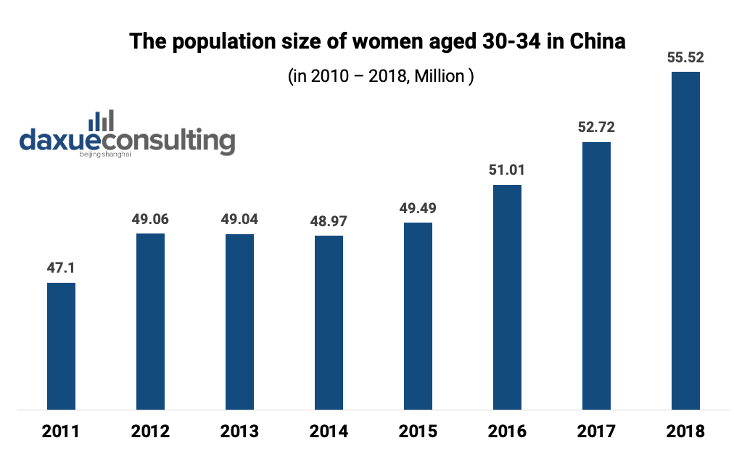
Data source: National Bureau of Statistics, The population size of women aged 30-34 in China
Independence and the pursuit of happiness have gradually become the mainstream of the concept of marriage. In recent years, the marriage rate has declined, and the divorce rate has increased. In 2017, the YOY growth rate for marriage and divorce are -7% and 5.2% respectively. These trends also show that with the development of society, contemporary women have broken away from the ‘sage model’, which requires women to be tolerant to maintain a marriage.
More and more women choose to marry after 30. In recent years, the number of registered marriages under 25 has dropped rapidly while the proportion of married people over 30 years old is rising. This trend reflects the delay of people’s first marriage. The new value regarding to marriage has resulted in conflicts between generations. The parents of Chinese women over 30 urge their children to marry early. Some parents even use a dating app to help their adult children find suitable partners and arrange a date.
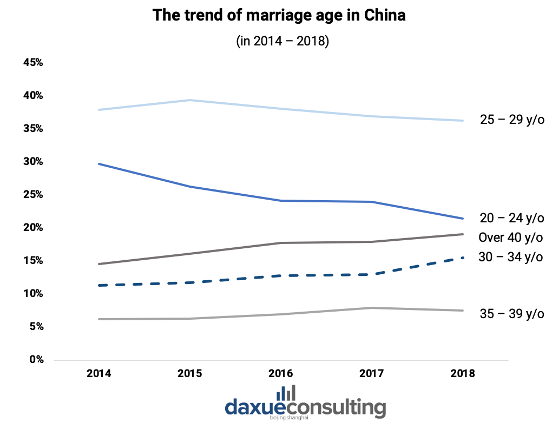
Data source: National Bureau of Statistics, daxue consulting analysis, the trend of marriage age in China
The segmentation of women over 30 in China
Workplace, marriage and parenting are the three major ‘battlefields’ for Chinese women over 30.
Women’s 30s is the golden period for careers, as they have accumulated a certain amount of work experience. Accordingly, Chinese 30+ women have a strong preference for professional social applications, which is proof of their success in careers.
For Chinese 30+ single women, they are vulnerable to the pressure of marriage under the conflict with the elder generation in the value of marriage. Therefore, finding a partner becomes a priority.
Based on their main focuses and characteristic, Chinese 30+ women can be categorized into three types: 30+ singe women, 30+ working women, and 30+ housewives. Both Chinese 30+ single women and 30+ working women have less financial pressure but Chinese 30+ housewives have the comfort of their own family.
The lifestyle of Chinese women over 30
The majority of women aged over 30 live a healthy lifestyle. According to Meiyou, a platform focusing on providing online services for women which nudges users to ‘check-in’ during certain activities, the top five habits registered by check-ins by women over 30 are all related to health.
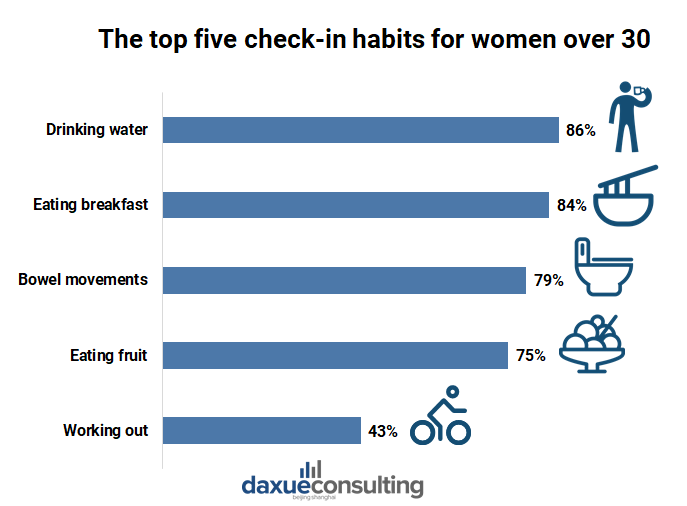
Data source: Meiyou, daxue consulting analysis, the top five 30+ women check-in habits
Interests and hobbies of 30+ year old Chinese women
As a branch of the post-80s generation, Chinese women over 30 have grown accustomed to the mobile application lifestyle after living years in the mobile Internet boom. 30 is a turning point for a woman where they often stop living for others and start pursuing their own interests.
Chinese 30+ Single women prefer to travel in their spare time, and hence the most used App type is related to travel service. They also kill the time by watching reality shows and anonymous online social.
Chinese 30+ working women pay more attention to their careers, and hence rely on human resource APP to communicate and work.
As Chinese 30+ housewives gradually enter marriage and family life, their burden to take care of a family and children is increasing, and hence their focus began to shift. Parenting and childcare becomes one of the focuses. Their reading themes are also different from those in other groups. Most information they read is related to the maternal-child topic.

Data source: Talking Data, daxue consulting design, top 10 App types used by Chinese 30+ women
During spare time, Chinese 30+ women share common interests in shopping and TV dramas or variety shows. However, differences also exist among the three groups.
Single women over 30 pay more attention to fitness, so they spend a lot of time at the gym. On the contrary, working Women over 30 pay more attention to social networks, so they prefer to participate in social activities, like dining with friends. Housewives over 30, however, enjoy the fun of gourmet cooking and outings with family.
Purchasing behavior of Chinese women over 30
Chinese 30+ women have simple requirements for food service, with 73% of them keeping their daily food-related expenditure within 70 yuan.
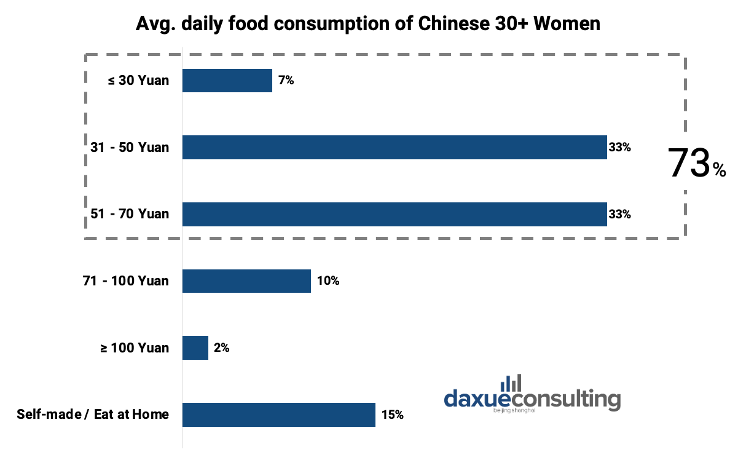
Source: Wenjuan, Avg. daily food expenditure of Chinese 30+ women
As a country with established E-commerce, online shopping has established a stable market position in the minds of Chinese women over 30. These three groups have different online shopping preferences for platforms and applications.
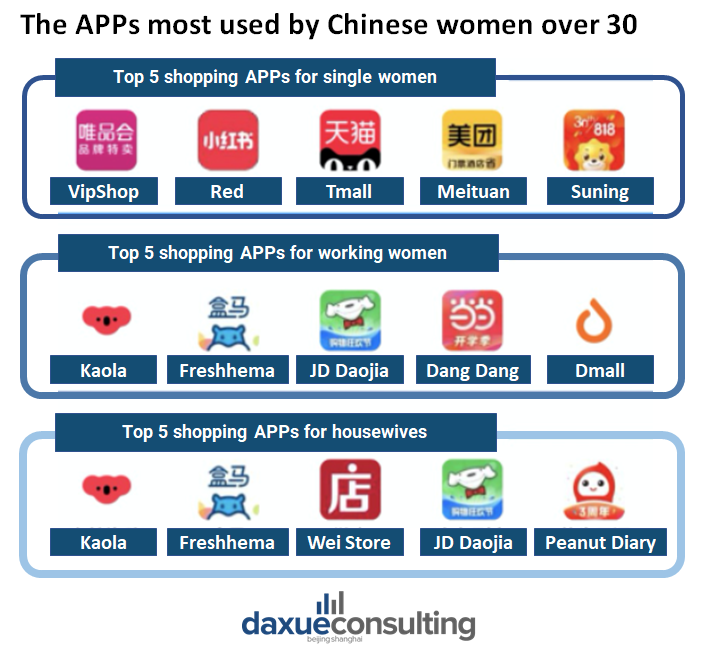
Data source: Talking Data, The Apps most used by Chinese women over 30
One obvious feature of online shopping platforms is various promotions, discounts, etc. All commercial activities tempt buyers with discounts and deals, but not all Chinese 30+ women treat it the same. According to the product reviews/promotion sensitivity research conducted by Talking Data, when faced with promotions and sales, Chinese single women over 30 are more likely to be indifferent, while and working women stay calm to evaluate their purchase, but housewives are the least likely to resist the temptation.
What causes hot discussions about women over 30 in China
Nothing but Thirty
Nothing but Thirty (三十而已) is a hit television series prevailing in the summer of 2020. The Chinese drama features the story of three women from different backgrounds. The drama depicts how these three women take matters into their own hands while reaching their thirties, a crucial stage for a woman.

Source: Tencent Video, Nothing but Thirty
Nothing but Thirty is all the rage, with over 20 billion views and flooding Weibo discussions. It also got a 6.8 out of 10 rating on Douban, a Chinese online reviewing platform.
It has kept its widespread popularity, since it has on the air. According to the average daily DAU of Tencent Video, the DAU was 98 million before the broadcast, 111 million DAU during the broadcast, and dropped back to 100 million DAU after the ending.
According to Baidu Index, its popularity is more significant when comparing with another popular drama, twenty your life on (二十不惑) playing in the same period.

Data source: Baidu Index, The search trend of ‘Nothing but Thirty‘ compared to the drama ‘Twenty Your Life On’
Viewer portrait
Women over 30 take over 50% of the viewers. This mainly because Nothing but Thirty resonates with many female viewers and demonstrates the struggles of Chinese thirty women.
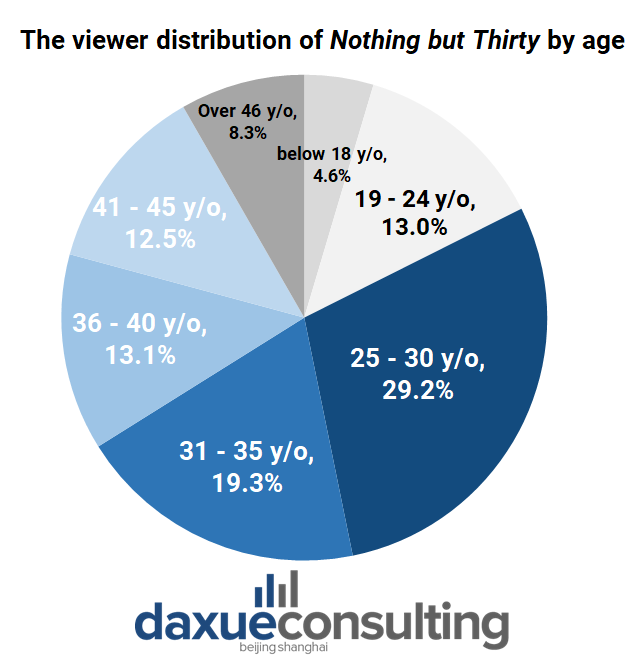
Data source: QuestMobile, Viewer Distribution of Nothing but Thirty by Age
In China, thirty-year-olds are expected to be married, hence being a single and thirty-something woman is considered unconventional. This drama truly reflects thirty-something women’s lives and educates the society that each woman is unnecessarily endowed with the so-called ‘protagonist’s halo’.
Sisters Who Make Waves
Sisters Who Make Waves is a hit reality show which began airing on June 12th, 2020. It features 30 celebrities from different backgrounds. The plot has followed the goal to organize a seven-people group. Although it referred to the general formula talent show, like Produce 101 (创造101), the twist is that all participants are already famous singers, actresses and are all over 30 years old. Every celebrity is required to train for a dancing and singing performance in a limited time, each round eliminating players until the top seven are left.

Source: Mango TV, Sisters Who Make Waves
Its popularity is overwhelming, even when compared with other hit show Street Dance of China (这!就是街舞), which broadcasted at the same period.

Data source: Baidu Index, The search trend of ‘Sisters Who Make Waves‘ compared to popular show ‘Street Dance of China’
Case study: How brands market via ‘Sisters Who Make Waves’
According to the viewer portrait by Endata, Working Women aged 25-35 are the main audience of Sisters Who Make Waves. Among the viewers, 78% are women and 46.7% are aged 25 -35. Most of them prefer to do online shopping, finance and travel. Based on their preference, some brands like Buick, New Balance, find the participating celebrities to advertise their products.
Other reasons many advertisers contracted with the reality show or the participants is the strong purchasing power of the viewers and their followers. The proportion of people whose spending power over 1,000 RMB is also higher than the proportion of that on the entire network.
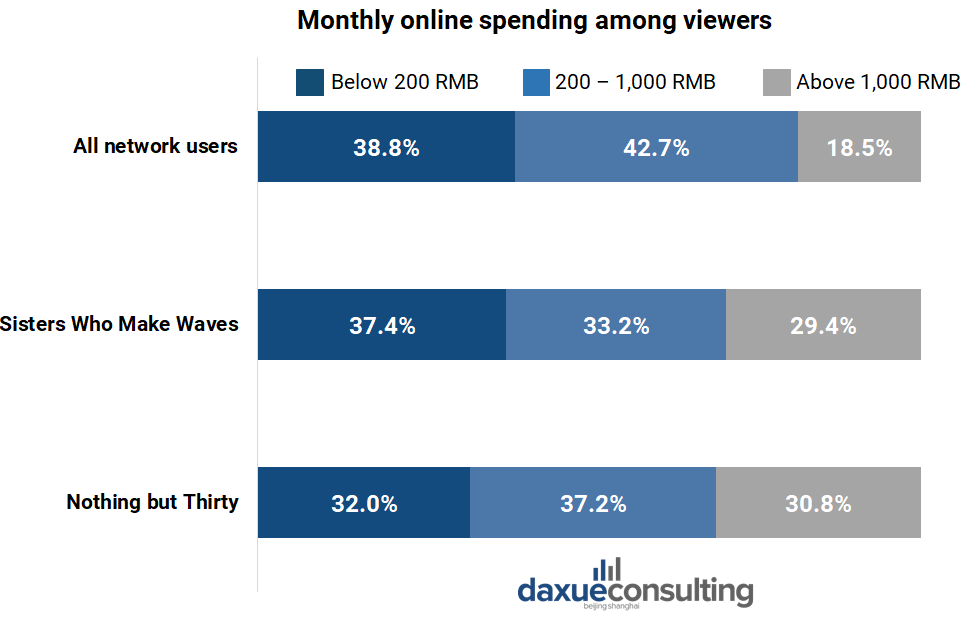
Data source: Quest Mobile, daxue consulting analysis, distribution of online spending per month
How to market to Chinese women over 30
With the rising popularity of these TV shows, Weibo and video media users are more interactive.
Therefore, related endorsed brands relied on the users’ interaction on Weibo, Bibibili, and video platforms to raise brand popularity.

Data source: Endata, Sisters Who Makes Waves’ popularity on different Channels
When more and more people joined and talked about the variety shows, the participating celebrities met a second wave of popularity. To leverage the traffic of each celebrity, brands collaborated with them in many ways, like signing a celebrity endorsement, inviting one to a Pop-Up store.
As for celebrities’ traffic management, the single-platform model (Weibo) has been broken. The dual-platform (‘Weibo + Douyin’ or ‘Weibo + Red’) or even three-platform (Weibo + Douyin + Red) have been used.
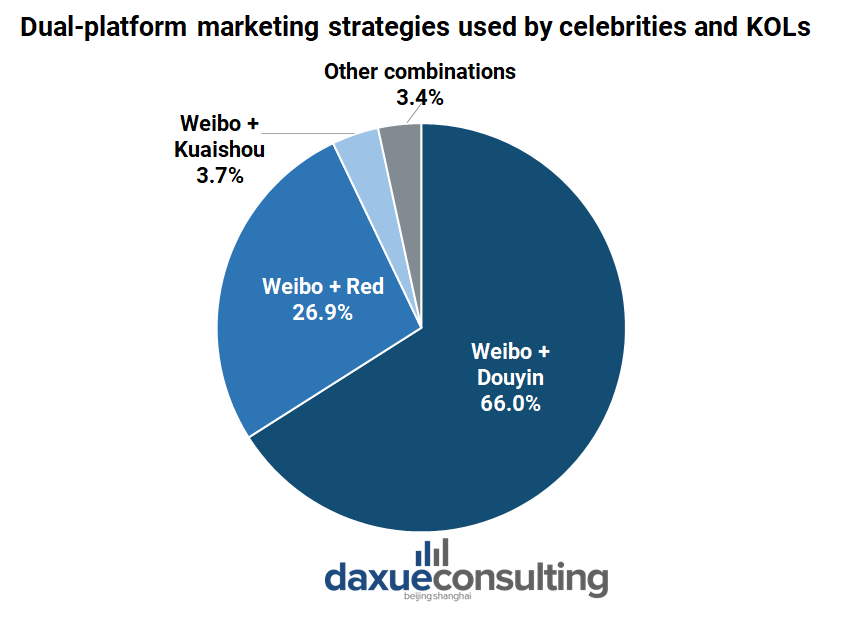
Data source: QuestMobile, Dual-platform marketing strategy used by celebrities and KOLs
Celebrities mainly use Weibo for promotions, and Weibo + Douyin is the most used dual-platform mode. This is mainly because the significant active users are on these two platforms.
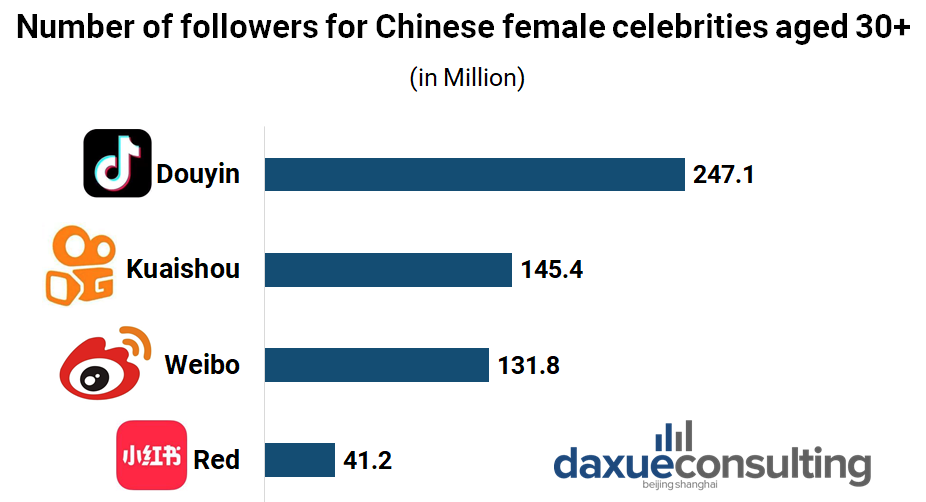
Data source: QuestMobile, Number of followers for Chinese celebrities aged 30+
Celebrities over 30 interact with followers on social platforms. They take the character of the platforms and their followers’ strength into account to design the marketing contents and formats and choose the platforms.
Tips for businesses targeting women over 30 in China
Accurately capture the content that can attract Chinese 30+ women
As we can see, the hit show and drama can harvest such popularity and profit is mainly because of the spirit of women they convey and the resonance with today’s women. Depending on whether the brand’s target market fits the profile of single, working, or housewives, brands can reach each group through different hobbies and platforms. Overall, women over 30 are very keen on health and wellness.
Deep-dive analysis of each segmentation
Although Chinese 30+ women share some characteristics, there are some differences in different aspects. For example, among the top five online shopping applications used, fast-delivered Apps, like Freshhema and JD daojia, do not list in the Top 5, which may because they don’t usually cook themselves at home, and hence buy less fresh food.
Choose the right marketing message
The newest wave of Chinese women over 30 will reject marketing messages that do not align with their beliefs in women empowerment in the workplace, and at home. Many of these women have already moved past the societal pressures placed on them to get married, hence marketing should not feed into negative misconceptions about a women’s place in the world. Additionally, these women are indifferent towards promotions and sales, and need a deeper motivation to purchase one brand over another.
For more insights about about Chinese consumer segments, email our project team at dx@daxueconsulting.com.
Chinese women are not the only ones making waves, check out our report on the rapid growth of Chinese male beauty consumers
Listen to over 100 China entrepreneur stories on China Paradigms, the China business podcast
Listen to China Paradigm on Apple Podcast






